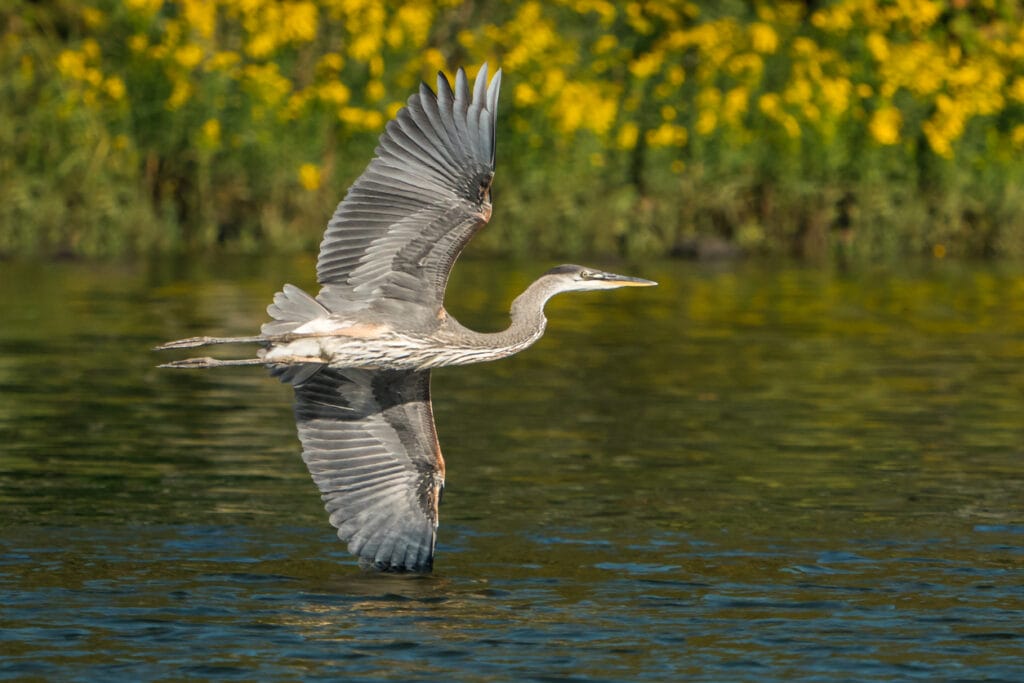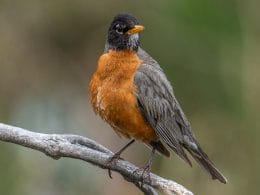Birds have that sort of magnificent glory that’s associated with their flying techniques. For bird observers, it can give them unlimited happiness to watch a bird soar or glide seamlessly. Yet, sometimes, you’ll see only a speck of a bird at a high altitude and wonder silently: ‘How high can a bird fly before it dies?’
Well, unfortunately, studies haven’t yet discovered an exact point at which the birds will suddenly lose all their flying energy. Still, scientists were able to record instances of birds traveling as high as 29,000 feet.
Now, are you ready to learn more about this topic more in-depth?
How High Do Birds Normally Fly?
When not migrating, the majority of birds tend to stick to an altitude of 500 feet. They won’t need to go any higher when they’re near their homes so as not to spend their energy. Plus, the higher that a bird flies, the more likely it’ll be in the range of the sharp vision of hawks. This is crucial when thinking about how high can a bird fly before it dies.
Yet, that doesn’t mean that birds aren’t capable of flying at higher altitudes. It’s just that they prefer to keep it under 500 feet in normal conditions.
Author Note: Still, many bird species have habitats that are over 13,000 feet above sea level. So, in order to get to their homes, these birds will cruise at this altitude or even higher.
What’s even more impressive is how high some small birds can go. For example, sparrows and hummingbirds in Alpine habitats could be seen at altitudes of around 16,000 feet. Also, Andean condors can reach a height of 18,000 feet when aided by strong air currents.
Lastly, we have to mention Mallard ducks in this discussion. These professional flying machines can be seen at 21,000 feet high. Who knew ducks were capable of such awesomeness?
How High Do Migrating Birds Fly?

Migrating birds have an amazing record when it comes to flying at higher elevations. Since these creatures usually need to fly for hours non-stop, they have no business trying to keep close to the land.
Plus, migrating birds climb to great heights to avoid dehydration in the warmer air that’s close to the ground. This helps them preserve their energy, which they must keep intact for their long migration routes.
As an example of this behavior, take a look at birds that migrate in the Caribbean. Scientists have noticed that these little buddies can soar around 10,000 feet. Although, some birds have been found to fly half or twice that high.
Generally speaking, migrating birds tend to start their journeys at about 5,000 feet. Then, their altitude gradually climbs throughout their flight until it gets to around 20,000 feet.
This mimics how a jet plane works. See, the optimum cruising altitude increases as the fuel is used up and the weight is reduced. Yet, not only migrating birds can reach these amazing heights.
What Is the Maximum Height That Birds Can Reach?
Theoretically, birds can go as high as airplanes safely do without facing any sort of trouble. In other words, these magnificent creatures are capable of reaching an altitude of 40,000 feet. This is around the same height as a coasting commercial airplane.
But, has there been any actual evidence of such incidents, or are we merely talking theories?
Luckily, there were some instances where birds managed to break world records for the highest flight capabilities.
For example, the endangered Ruppell’s Griffon Vulture has been spotted flying at a roaring 37,000 feet. This was reported in 1974 after this mighty beast collided with an airplane that flew at the same altitude.
Author Note: Another remarkable instance of such ability is how the Bar-headed Goose manages to fly over the Himalayas during migration. That’s as high as 28,000 feet. Pretty impressive, ha?

Sure, it’s normal to assume that high flyers will exert themselves at some point due to the lack of oxygen. Also, the air tends to be colder and crisper, so the birds need to stay as warm as possible to prevent hypothermia. Yet, have you ever wondered about what keeps them going?
In this section, we’ll go through a few things that help birds navigate so high in the sky.
Long Wingspans
The first factor that keeps birds steady at the higher elevations is their wingspans. See, all high-flying birds have one thing in common, which is a wingspan to body ratio that’s larger than that of low-flying birds.
With longer wingspans, birds can generate more lift to keep their bodies soaring at impressively higher altitudes. But large wingspans aren’t enough on their own to help a bird overcome the challenges that appear at such high points in the sky.
Physical Adaptations
Besides their majestic wingspans, birds have developed physical mechanisms to help them stay safer at high altitudes. Let’s explore them more in-depth.
For example, the first challenge any bird would normally face at these heights is that the air gets less dense. As a result, the bird will have to flap harder to stay aloft, leading to the need to increase its metabolism.
So, how does a bird get more oxygen when there’s already less of it at such high elevations?
Well, let’s take a look at the behavior of bar-headed geese in this situation. A goose will start to hyperventilate at this point, increasing its oxygen intake. Yet, unlike us humans, breathing rapidly won’t make a goose feel ill or dizzy.
When we hyperventilate, our blood becomes more alkaline, which affects circulation to the brain. On the other hand, geese can tolerate the change in their blood pH levels. So, the blood flow to their brains remains healthy.
Another plus point that enables the geese to stay stable is that the hemoglobin in their blood binds quickly with oxygen. Once again, this helps keep their oxygen intake to the maximum.
A Secret Flying Strategy
The last factor that helps high-flying birds stay as safe as possible is their roller-coaster flight strategy. These skilled flyers don’t stay high for too long, especially during their migration.
Take the Bar-headed Goose for example. These birds travel up to 3,000 miles, if not more, with flight periods that can extend for anything between 5 to 200 hours. So, how do they manage to stay aloft for such a great amount of time?
Author Note: The geese will usually change their altitudes depending on the obstacles they’re facing. For instance, they may remain at 16,000 feet of height, then climb up to 18,000 or 19,000 feet when facing a mountain range.
Then, after the geese have crossed an especially challenging obstacle, they would come down right away to rest. This up-and-down strategy gives the birds enough energy to reach high elevations without consuming too much power.
Sheer Will

Sometimes, flying at high altitudes can be beneficial in and of itself, so some birds choose to do it without a second thought.
See, flying high gives migratory birds an advantage because it doesn’t expose them to predators. Since most hawks or birds of prey will fly at lower altitudes, migrating birds aim to stay outside these beasts’ range.
Plus, at these heights, the birds can use the help of tailwinds to fly with less effort. Not to mention that the air is cooler at this point, keeping overheating at bay.
What Happens If Birds Fly Too High?
Even though many bird species are skilled high-flyers, they still have their limits. If they fly for too long at high elevations, they’ll soon overexert their muscles and become tired.
Also, the oxygen drop will be too intense for their bodies to keep up with, which can decrease metabolism. As a result, the energy will go down, which can be pretty risky when a bird is thousands of feet from the ground.
But there’s nothing to worry about, though, because birds almost never allow themselves to reach that point. These smart creatures know their limitations. So, for the most part, they manage to navigate the skies just fine without trouble.
Some birds might find themselves in the presence of an airplane, which might interfere with their path. But again, birds would normally know how to stay out of its way.
Final Words
Birds are magnificent creatures, and it doesn’t matter if we’re talking about vultures, geese, ducks, or songbirds. They’re all equally fascinating to watch in their natural habitats, especially when they’re in flight.
But, how high can a bird fly before it dies?
The thing is, birds won’t reach some point in the sky and suddenly stop functioning. Instead, they might face a drop in their oxygen intake, which they can easily overcome by flying lower.
Still, if you’re eager to know, the max height that some birds were able to fly at was 37,000 feet. With the help of certain body adaptations, some birds, like the bar-headed geese, were up for the challenge. We hope you enjoyed this article on how high can a bird fly before it dies.
Fly high (but not too high) friends!
FAQ
Yes. The cruising altitude of a large plane is around 33,000 feet and there have been recordings of birds also flying at that height! Some other examples of high fliers are the Common Crane and Whooper Swan.
Yes, although it might not look like sleep as we know it. Studies have shown that some birds put half their brain into deep sleep while the other half keeps an eye on things, so to speak.
There are several reasons but the main thing we have to remember is how light they are. Their bones are hollow and feathers by their nature are very light. Also, they are designed to fly. For example, albatross can lock their wings into place at the shoulder which means they do not have the effort of holding them up.










